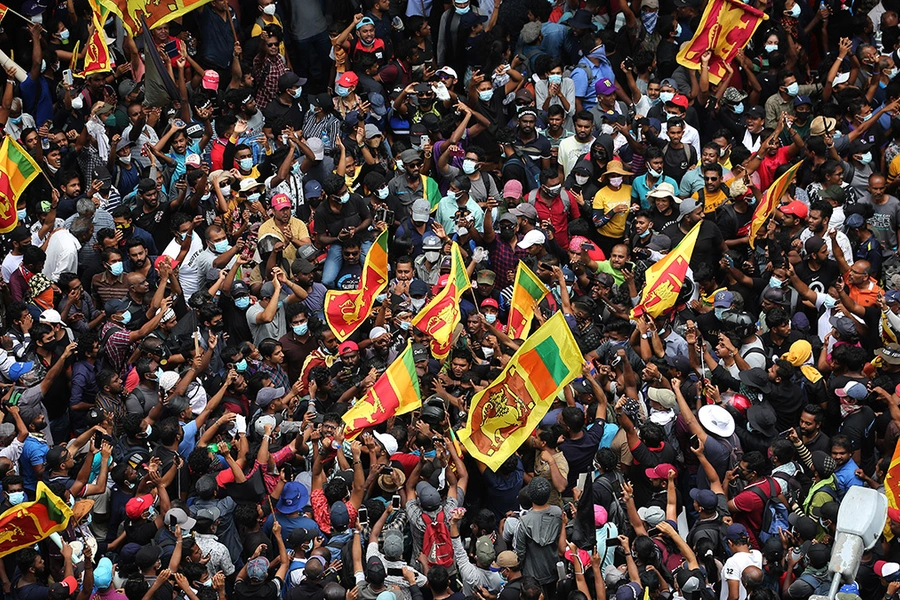Akhil Bery

For over one hundred days, Sri Lankans have been protesting in the streets while the country faces its worst economic crisis since independence in 1948. The crisis has long been in the making; successive governments have failed to enact policies that insert Sri Lanka into the global supply chain, instead opting for protectionist measures. This has exacerbated the “twin deficit” problem in which Sri Lanka faces both a budget deficit and a current account deficit. At the same time, Sri Lanka’s debt obligations have expanded as politicians invest in infrastructure projects, including a number of commercially unviable vanity projects. Sri Lanka has raised this funding from both international investors, who account for about 37 percent of the country’s overall debt profile, and bilateral creditors such as China and Japan. China is Sri Lanka’s largest bilateral creditor, accounting for about 10.8 percent of Sri Lanka’s overall debt. These debt obligations are a major reason why Sri Lanka is facing this current crisis.
Debt has long been a problem that former President Gotabaya “Gota” Rajapaksa never addressed. Instead, he enacted a series of policies that worsened the situation. When he came to power in 2019, Gota Rajapaksa implemented a value-added tax cut and an income tax cut despite warnings from the International Monetary Fund (IMF) not to do so. According to the IMF, in 2020, these tax cuts cost Sri Lanka over 2 percent of its gross domestic product (GDP) in lost revenue, hurting its ability to pay its debt. The other ill-timed policy was the implementation of a ban on the import of non-organic fertilizers without preparing farmers for the change. Within six months, rice production dropped by approximately 20 percent, forcing the government to import about $450 million worth of rice and putting further pressure on foreign exchange reserves. When combined with the COVID-19 pandemic, which caused a significant drop in tourism, and Russia’s invasion of Ukraine, which increased oil and commodity prices, these two policies pushed Sri Lanka to default in May 2022.
Facing shortages of food, medicine, and fuel, as well as power cuts lasting up to thirteen hours per day, ordinary Sri Lankan citizens took to the streets to demand that the government resign. After protests briefly turned violent in May, Prime Minister Mahinda Rajapaksa–Gota Rajapaksa’s brother–and his cabinet resigned. Gota Rajapaksa stayed in office until finally fleeing the country and emailing his resignation from Singapore on July 14. Now, Prime Minister Ranil Wickremesinghe has stepped in as acting president, and Parliament is set to vote on a new president on July 20 to complete the rest of Gota Rajapaksa’s term. At the time of writing, there are several viable candidates, but Wickremesinghe is favored to win as he retains the backing of the Rajapaksas’ party, Sri Lanka Podujana Peramuna (SLPP).
Sri Lanka needs political stability to ensure that negotiations with the IMF conclude quickly, which will unlock additional bilateral and multilateral financing. According to Wickremesinghe, the country requires an estimated $6 billion in additional financing this year, which will only arrive if an IMF program is in place. A new government is likely to finish negotiations with the IMF. However protesters are unlikely to be mollified, especially if Wickremesinghe, who is widely unpopular despite SLPP’s support, is elected president. In the last election, Wickremesinghe lost his long-time seat in Colombo and had to be nominated to enter Parliament via the national list, which is based on the party’s percentage of the national vote, rather than a direct election. Protesters also accuse Wickremesinghe of protecting the Rajapaksas and failing to prosecute them for alleged corruption and other crimes.
The incoming government has a delicate geopolitical dynamic to navigate. Throughout the crisis, India has emerged as Sri Lanka’s best friend, championing the country’s case at the IMF and providing about $4 billion in assistance. The Indian government also created a task force to determine how else it can help. In contrast, China, which had strong ties with the Rajapaksas and benefited from numerous policy decisions under them, has not provided the debt relief Sri Lanka desperately needs. Though Sri Lanka has negotiated with China on debt restructuring, Chinese officials are unlikely to agree to Sri Lanka’s terms because they prefer refinancing loans and fear it would set a precedent for other countries facing similar debt issues.
Ultimately, Sri Lanka’s economic situation will not improve any time soon. Even if the new government is able to conclude negotiations with the IMF, it will take time for the money to be dispersed. In the meanwhile, Sri Lanka will have to either pay its external creditors or pay for essential goods. Compounding the challenge, protesters are unlikely to see the government as legitimate, which could hamper the ability to implement sensitive economic reforms. Continued protests could pave the way for elections later this year or next year.
No comments:
Post a Comment